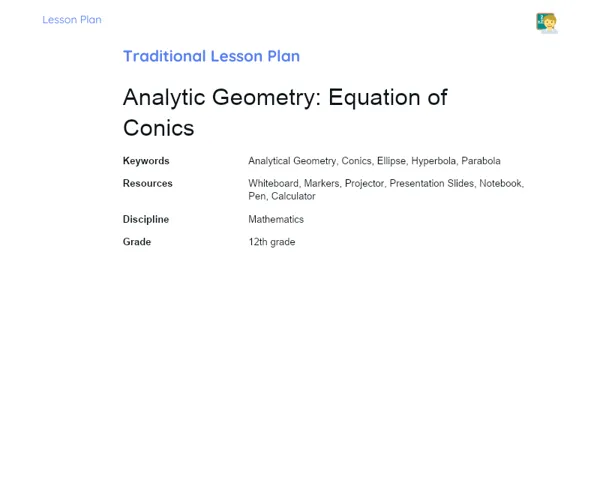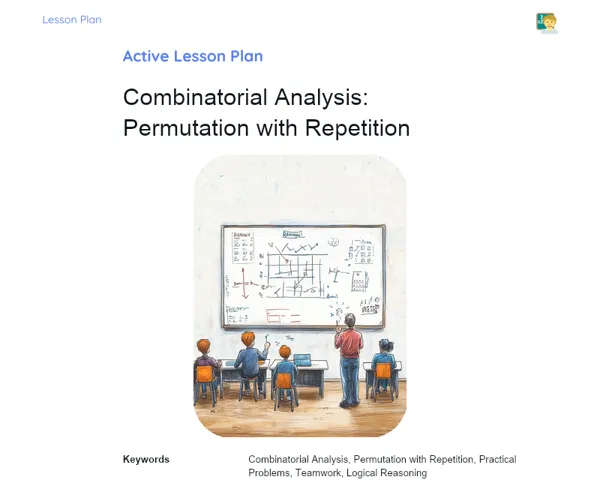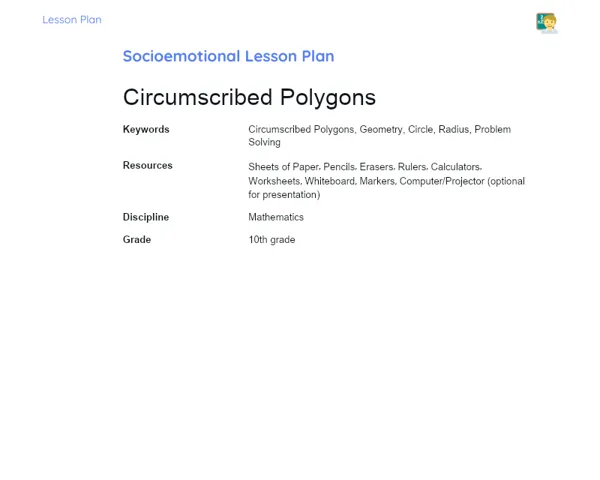Lesson Plan | Active Methodology | Perimeter and Area Relationship
| Keywords | Perimeter, Area, Regular polygons, Mathematical relationships, Calculation, Practical applications, Problem-based real-life situations, Teamwork, Practical activities, Group discussion, Mathematical reasoning, Gardening, Urban planning, Everyday life |
| Necessary Materials | Graph paper, Scissors, Rulers, Building blocks, Measuring tape, Cards with various shapes and dimensions |
Premises: This Active Lesson Plan assumes: a 100-minute class duration, prior student study both with the Book and the beginning of Project development, and that only one activity (among the three suggested) will be chosen to be carried out during the class, as each activity is designed to take up a large part of the available time.
Objective
Duration: (5 - 10 minutes)
This stage is key to setting the tone for the lesson and ensuring that both the teacher and students clearly understand the expectations. By laying out the objectives clearly, students can focus their efforts on acquiring the skills they need, while the teacher can craft activities that optimize comprehension and application of perimeter and area concepts in regular polygons.
Objective Utama:
1. Compare the perimeter and area of regular polygons to identify the mathematical relationships between these measures.
2. Analyze how the perimeter and area of a regular polygon change when the side length is altered.
Objective Tambahan:
- Enhance mathematical and logical reasoning skills by engaging with formulas and geometric concepts.
Introduction
Duration: (15 - 20 minutes)
The Introduction stage aims to engage students and refresh their prior knowledge regarding the link between perimeter and area through real-life scenarios that encourage applying these concepts practically. Additionally, it helps students recognise the relevance of what they're learning in the real world, enhancing their interest by showing the everyday and professional implications of their lessons.
Problem-Based Situation
1. Picture a rectangular garden plot that measures 40 metres in length and 30 metres in width. How would you calculate the fencing needed to completely enclose it? What if it were transformed into a square plot, with each side measuring 40 metres?
2. An architect is in the process of designing a new park, which will feature a circular fountain with a radius of 10 metres and a rectangular pathway around it. If the total perimeter of the entire park is restricted to 200 metres, what width should the pathway be?
Contextualization
Grasping the relationship between perimeter and area is essential, not just in mathematics, but also in our everyday lives, including fields like construction, landscaping, and event management. For instance, when you're figuring out the amount of paint needed to cover a wall, understanding the area is vital, whereas the perimeter is crucial for determining how much material is required for a door frame. These practical examples underscore why studying this topic is so important.
Development
Duration: (70 - 75 minutes)
The Development stage allows students to collaboratively and practically apply the perimeter and area concepts they learned earlier. Through engaging and contextual activities, they will reinforce their understanding, sharpen their calculation and reasoning skills, and cultivate teamwork. Each activity is designed to explore various dimensions of the relationships between perimeter and area, ensuring a robust and comprehensive comprehension.
Activity Suggestions
It is recommended that only one of the suggested activities be carried out
Activity 1 - Geometric Gardens Challenge
> Duration: (60 - 70 minutes)
- Objective: Apply the principles of perimeter and area in crafting a realistic project, honing calculation and visualization skills.
- Description: Students will work in groups of up to 5 to design a garden layout that features flower beds of various shapes (squares, rectangles, circles) and pathways connecting them, using graph paper and scissors. Each group will need to calculate the total perimeter for both the flowerbeds and paths, as well as the area of each individual flowerbed, determining the relationship between the garden's total area and perimeter.
- Instructions:
-
Split the class into groups of no more than 5 students.
-
Provide graph paper, scissors, and rulers.
-
Each group is to create a garden layout on the graph paper, placing flowerbeds and paths appropriately.
-
Calculate the perimeter and area of each shape created and note these values.
-
Add up the perimeters to find the total perimeter of the garden, including both flowerbeds and paths.
-
Compute the garden's overall area.
-
Present the project and calculations to the class, explaining the relationships observed between perimeter and area.
Activity 2 - Geometric Olympics
> Duration: (60 - 70 minutes)
- Objective: Enhance quick and accurate calculation skills while fostering teamwork and critical thinking.
- Description: In this fun-filled activity, students will compete in groups to tackle perimeter and area challenges involving regular polygons. Each group will receive cards with various shapes and dimensions and will need to compute the perimeter and area for each polygon. Points will be awarded based on the accuracy and speed of their calculations.
- Instructions:
-
Organize the classroom with different stations, each having a set of cards with shapes and dimensions.
-
Group the students and assign a station to each team.
-
Each group will calculate the perimeter and area of each shape as quickly as they can.
-
Rotate the groups to different stations after a signal, ensuring everyone has a chance to solve all problems.
-
Score the groups based on their accuracy and response times.
-
Declare the winning group at the end of the session.
Activity 3 - World Builders
> Duration: (60 - 70 minutes)
- Objective: Apply the concepts of perimeter and area in a hands-on project, fostering creativity and spatial awareness.
- Description: Working in groups, students will take on the roles of architects and urban planners, designing a miniature city within a predetermined area. Using geometric shapes to represent buildings and public spaces, they will calculate the perimeters and areas to ensure their designs fit within the given space.
- Instructions:
-
Divide the class into groups of up to 5 students.
-
Distribute materials like building blocks, graph paper, and measuring tape.
-
Each group is to design their city's buildings and public spaces within the designated area.
-
Calculate the perimeter and area for each constructed building and public space.
-
Make sure the project fits within the allotted area without exceeding perimeter constraints.
-
Showcase the finished project to the class, detailing the calculations and design choices made.
Feedback
Duration: (15 - 20 minutes)
This stage aims to solidify learning, allowing students to articulate what they've absorbed and contemplate the applicability of perimeter and area concepts. Group discussions help develop communication and critical thinking skills, enabling students to learn from each other by sharing diverse viewpoints and strategies. This layer also allows the teacher to gauge understanding and address any remaining questions.
Group Discussion
After completing the activities, gather everyone in a large discussion circle. Kick off the conversation with a brief overview, revisiting the key objectives of the lesson and connecting how the activities relate to daily life applications. Invite each group to share their experiences and any challenges they faced during their tasks. Encourage students to explain the strategies they employed to tackle the problems and how they translated theory into practice.
Key Questions
1. What were the biggest challenges faced when calculating the perimeter and area of the gardens or cities?
2. How does changing the side length of a polygon influence its perimeter and area? Did you see any patterns emerge?
3. In what other everyday scenarios can you apply your knowledge of perimeter and area that weren't covered in the activities?
Conclusion
Duration: (5 - 10 minutes)
The aim of this Conclusion stage is to ensure students have a solid and consolidated grasp of the concepts covered during the lesson, linking theoretical insights to the practical activities undertaken. Additionally, it seeks to underline the significance and relevance of perimeter and area concepts in students' daily experiences, preparing them for future contexts, whether academic or professional.
Summary
To wrap up, the teacher should recap the essential learnings from the lesson, reinforcing the connections between perimeter and area and their practical applications. It's important to revisit the formulas and methods discussed, ensuring every student grasps these concepts before moving forward.
Theory Connection
Through the lesson, students directly recognized how mathematical theories manifest in practical situations via activities mimicking real-world tasks such as urban planning and gardening. This hands-on method not only solidified theoretical understanding but also showcased how important perimeter and area knowledge is in their daily lives.
Closing
Finally, it's vital to stress the significance of understanding perimeter and area, emphasizing that these concepts are foundational not just for mathematics, but for numerous professions and everyday scenarios. Mastering these measures is crucial for addressing practical challenges and developing analytical and critical skills across various fields.



